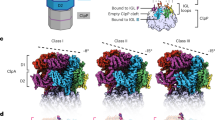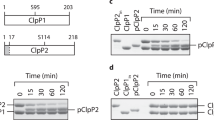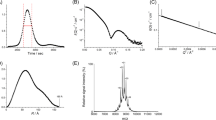Abstract
Tripeptidyl peptidase II (TPP II) is the largest known eukaryotic protease (6 MDa). It is believed to act downstream of the 26S proteasome, cleaving tripeptides from the N termini of longer peptides, and it is implicated in numerous cellular processes. Here we report the structure of Drosophila TPP II determined by a hybrid approach. We solved the structure of the dimer by X-ray crystallography and docked it into the three-dimensional map of the holocomplex, which we obtained by single-particle cryo–electron microscopy. The resulting structure reveals the compartmentalization of the active sites inside a system of chambers and suggests the existence of a molecular ruler determining the size of the cleavage products. Furthermore, the structure suggests a model for activation of TPP II involving the relocation of a flexible loop and a repositioning of the active-site serine, coupling it to holocomplex assembly and active-site sequestration.
This is a preview of subscription content, access via your institution
Access options
Subscribe to this journal
Receive 12 print issues and online access
$189.00 per year
only $15.75 per issue
Buy this article
- Purchase on Springer Link
- Instant access to full article PDF
Prices may be subject to local taxes which are calculated during checkout







Similar content being viewed by others
References
Yao, T. & Cohen, R.E. Giant proteases: beyond the proteasome. Curr. Biol. 9, R551–R553 (1999).
Tamura, T. et al. Tricorn protease—the core of a modular proteolytic system. Science 274, 1385–1389 (1996).
Tamura, N., Lottspeich, F., Baumeister, W. & Tamura, T. The role of tricorn protease and its aminopeptidase-interacting factors in cellular protein degradation. Cell 95, 637–648 (1998).
Brandstetter, H., Kim, J., Groll, M. & Huber, R. Crystal structure of the tricorn protease reveals a protein disassembly line. Nature 414, 466–470 (2001).
Walz, J., Tamura, T., Tamura, N., Grimm, R. & Baumeister, W. Tricorn protease exists as an icosahedral supermolecule in vivo. Mol. Cell 1, 59–65 (1997).
Tomkinson, B. Tripeptidyl peptidases: enzymes that count. Trends Biochem. Sci. 24, 355–359 (1999).
Reits, E. et al. A major role for TPP II in trimming proteasomal degradation products for MHC class I antigen presentation. Immunity 20, 495–506 (2004).
York, I.A., Bhutani, N., Zendzian, S., Goldberg, A.L. & Rock, K.L. Tripeptidyl peptidase II (TPPII) is the major peptidase needed to trim long antigenic precursors, but is not required for most MHC class I antigen presentation. J. Immunol. 177, 1434–1443 (2006).
Firat, E. et al. Analysis of direct and cross-presentation of antigens in TPPII knockout mice. J. Immunol. 179, 8137–8145 (2007).
Endert, P. Role of tripeptidyl peptidase II in MHC class I antigen processing—the end of controversies? Eur. J. Immunol. 38, 609–613 (2008).
Kawahara, M. et al. Analysis of the role of tripeptidyl peptidase II in MHC class I antigen presentation in vivo. J. Immunol. 183, 6069–6077 (2009).
Hasselgren, P.O. Molecular regulation of muscle cachexia: it may be more than the proteasome. Biochem. Biophys. Res. Commun. 290, 1–10 (2002).
Stavropoulou, V., Vasquez, V., Cereser, B., Freda, E. & Masucci, M.G. TPPII promotes genetic instability by allowing the escape from apoptosis of cells with activated mitotic checkpoints. Biochem. Biophys. Res. Commun. 346, 415–425 (2006).
Huai, J. et al. Activation of cellular death programs associated with immunosenescence-like phenotype in TPPII knockout mice. Proc. Natl. Acad. Sci. USA 105, 5177–5182 (2008).
Rose, C. et al. Characterization and inhibition of a cholecystokinin-inactivating serine peptidase. Nature 380, 403–409 (1996).
McKay, R.M., McKay, J.P., Suh, J.M., Avery, L. & Graff, J.M. Tripeptidyl peptidase II promotes fat formation in a conserved fashion. EMBO J. 8, 1183–1189 (2007).
Rockel, B. et al. Molecular architecture and assembly of Drosophila tripeptidyl peptidase II. Proc. Natl. Acad. Sci. USA 102, 10135–10140 (2005).
Seyit, G., Rockel, B., Baumeister, W. & Peters, J. Size matters for the tripeptidase II complex from Drosophila: the 6-MDa spindle form stabilizes the activated state. J. Biol. Chem. 281, 25723–25733 (2006).
Steitz, T.A. & Shulman, R.G. Crystallographic and NMR studies of the serine proteases. Annu. Rev. Biophys. Bioeng. 11, 419–444 (1982).
Bode, W., Papamokos, E., Musil, D., Seemueller, U. & Fritz, H. Refined 1.2 Å crystal structure of the complex formed between subtilisin Carlsberg and the inhibitor eglin c. Molecular structure of eglin and its detailed interaction with subtilisin. EMBO J. 5, 813–818 (1986).
Schechter, I. & Berger, A. On the size of the active site in proteases. I. Papain. Biochem. Biophys. Res. Commun. 27, 157–162 (1967).
Engel, M. et al. The crystal structure of dipeptidyl peptidase IV (CD26) reveals its functional regulation and enzymatic mechanism. Proc. Natl. Acad. Sci. USA 100, 5063–5068 (2003).
Goettig, P. et al. X-ray snapshots of peptide processing in mutants of tricorn–interacting factor F1 from Thermoplasma. J. Biol. Chem. 280, 33387–33396 (2005).
Ito, K. et al. Crystal structure and mechanism of tripeptidyl activity of prolyl tripeptidyl aminopeptidase from Porphyromonas gingivalis. J. Mol. Biol. 362, 228–240 (2006).
Xu, Y. et al. Novel inhibitor for prolyl tripeptidyl aminopeptidase from Porphyromonas gingivalis and details of substrate-recognition mechanism. J. Mol. Biol. 375, 708–719 (2008).
Rao, S.N., Singh, U.C., Bash, P.A. & Kollman, P.A. Free energy perturbation calculations on binding and catalysis after mutating Asn 155 in subtilisin. Nature 328, 551–554 (1987).
Bryan, P., Pantoliano, M.W., Quill, S.G., Hsiao, H.Y. & Poulos, T. Site-directed mutagenesis and the role of the oxyanion hole in subtilisin. Proc. Natl. Acad. Sci. USA 83, 3743–3745 (1986).
Wells, J.A., Cunningham, B.C., Graycar, T.P. & Estell, D.A. Importance of hydrogen-bond formation in stabilizing the transition state of subtilisin. Phil. Trans. R. Soc. Lond. A 317, 415–423 (1986).
Carter, P. & Wells, J.A. Functional interaction among catalytic residues in subtilisin BPN′. Proteins 7, 335–342 (1990).
Guhaniyogi, J., Sohar, I., Das, K., Stock, A.M. & Lobel, P. Crystal structure and autoactivation pathway of the precursor form of human tripeptidyl-peptidase 1, the enzyme deficient in late infantile ceroid lipofuscinosis. J. Biol. Chem. 284, 3985–3997 (2009).
Geier, E. et al. A giant protease with potential to substitute for some functions of the proteasome. Science 283, 978–981 (1999).
Ito, K. et al. Crystal structure of aminopeptidase N (proteobacteria alanyl aminopeptidase) from Escherichia coli and conformational change of methionine 260 involved in substrate recognition. J. Biol. Chem. 281, 33664–33676 (2006).
Lindås, A.-C., Eriksson, S., Jozsa, E. & Tomkinson, B. Investigation of a role for Glu-305 and Glu-331 in substrate binding of tripeptidyl-peptidase II. Biochim. Biophys. Acta 1784, 1899–1907 (2008).
Löwe, J. et al. Crystal structure of the 20S proteasome from the archaeon T. acidophilum at 3.4 Å resolution. Science 268, 533–539 (1995).
Bode, W., Papamokos, E. & Musil, D. The high-resolution X-ray crystal structure of the complex formed between subtilisin Carlsberg and eglin c, an elastase inhibitor from the leech Hirudo medicinalis. Structural analysis, subtilisin structure and interface geometry. Eur. J. Biochem. 166, 673–692 (1987).
DeLano, W.L. The PyMOL Molecular Graphics System (2002) DeLano Scientific, Palo Alto, CA, USA <http://www.pymol.org>.
Pettersen, E.F. et al. UCSF Chimera—a visualization system for exploratory research and analysis. J. Comput. Chem. 25, 1605–1612 (2004).
Otwinowski, Z. & Minor, W. Processing of X-ray diffraction data collected in oscillation mode. Methods Enzymol. 276, 307–326 (1997).
Adams, P.D. et al. PHENIX: building new software for automated crystallographic structure determination. Acta Crystallogr. D Biol. Crystallogr. 58, 1948–1954 (2002).
Emsley, P. & Cowtan, K. Coot: model-building tools for molecular graphics. Acta Crystallogr. D Biol. Crystallogr. 60, 2126–2132 (2004).
Laskowski, R.A., MacArthur, M.W., Moss, D.S. & Thornton, J.M. PROCHECK—A program to check the stereochemical quality of protein structures. J. Appl. Crystallogr. 26, 283–291 (1993).
Ludtke, S.J., Baldwin, P.R. & Chiu, W. EMAN: semiautomated software for high-resolution single-particle reconstructions. J. Struct. Biol. 128, 82–97 (1999).
Wriggers, W., Milligan, R.A. & McCammon, J.A. Situs: a package for docking crystal structures into low-resolution maps from electron microscopy. J. Struct. Biol. 125, 185–195 (1999).
Acknowledgements
Diffraction datasets for the structure determination were collected at Beamline 8.2.2, Advanced Light Source, Lawrence Berkeley National Laboratory. We would like to thank C. Ralston and her beamline staff for their assistance. We thank A. Sonnen for the calculation of the contact areas. This work is supported by funding from the Deutsche Forschungsgemeinschaft (B.R.), the National Institutes of Health (B.K.J.) and the US Department of Energy.
Author information
Authors and Affiliations
Contributions
W.B. and B.K.J. conceived the project; X-ray crystallography work, from purification to final structure, was conducted by C.K.C. under the guidance of B.K.J.; P.J.W. was involved in data collection and processing and P.H.Z. in initial processing of data; G.S. and J.P. were involved with initial purification and crystallization trials; electron microscopy structural studies were performed by B.R.; A.-M.S. and J.P. performed mutation and functional studies; the manuscript was written by C.K.C., B.R., J.P., B.K.J. and W.B.; All authors read and edited the manuscript.
Corresponding authors
Ethics declarations
Competing interests
The authors declare no competing financial interests.
Supplementary information
Supplementary Text and Figures
Supplementary Figures 1–5, Supplementary Tables 1 and 2, Supplementary Methods (PDF 8659 kb)
Supplementary Video 1
Rotation about the spindle axis of two dimers docked into the central part of the TPP II envelope. The color–coding for the dimers is the same as used for Figure 1: yellow, subtilisin domain (residues 1–522); red, active site residues (Asp44, His272, Ser462, Asn374); orange, insert (residues 75–266); green, central domain (residues 523–1098); blue, C–terminal domain (residues 1099–1354); the adjoining monomers are shown in a lighter shade of the same color scheme. (MOV 3620 kb)
Rights and permissions
About this article
Cite this article
Chuang, C., Rockel, B., Seyit, G. et al. Hybrid molecular structure of the giant protease tripeptidyl peptidase II. Nat Struct Mol Biol 17, 990–996 (2010). https://doi.org/10.1038/nsmb.1870
Received:
Accepted:
Published:
Issue Date:
DOI: https://doi.org/10.1038/nsmb.1870
This article is cited by
-
Post-proteasomal and proteasome-independent generation of MHC class I ligands
Cellular and Molecular Life Sciences (2011)



